Super Destroyers. Alt SU-14
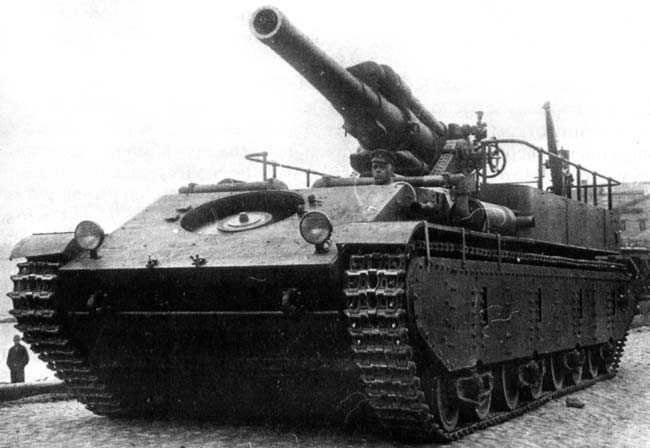
But, since there was no suitable chassis for such triplexes in 29 (as well as parts of artillery systems), the project was postponed for several years.
Later, the chassis decided to save. Case triplex to create on the chassis of a cheap T-26 (future SU-5), replacing only obviously for him a heavy 107 mm case gun on the 76,2 mm divisional. A triplex TAON to do on a special chassis using a combination of components and assemblies T-35 and T-28.
Since in 1933, the only new TAON artillery system (or the new RVGK) was the 31 mm howitzer B-203 developed in 4 and the serial production started only in 34, the first machine of the future triplex (SU-14) was decided to equip this very B-4.
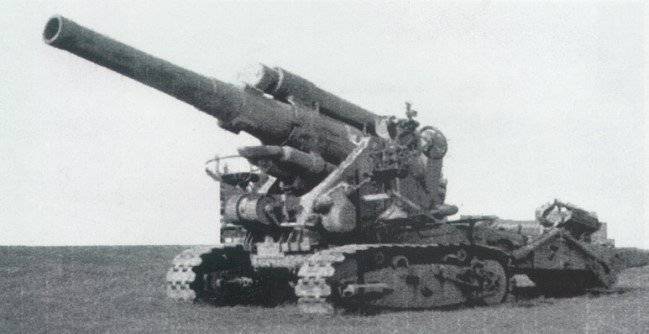
We decided to do it in 34.
During the tests, the self-propelled gun showed not bad results of shooting, but the wagon pumped up (or rather its suspension - the weight offered to her was not strong). It actually had to be re-designed, replacing weak nodes from T-28 with nodes from “thirty-fifth”, or with specially manufactured ones (neither T-28 nor T-35 were commercially produced in 1933 in the year, they were just mastered).
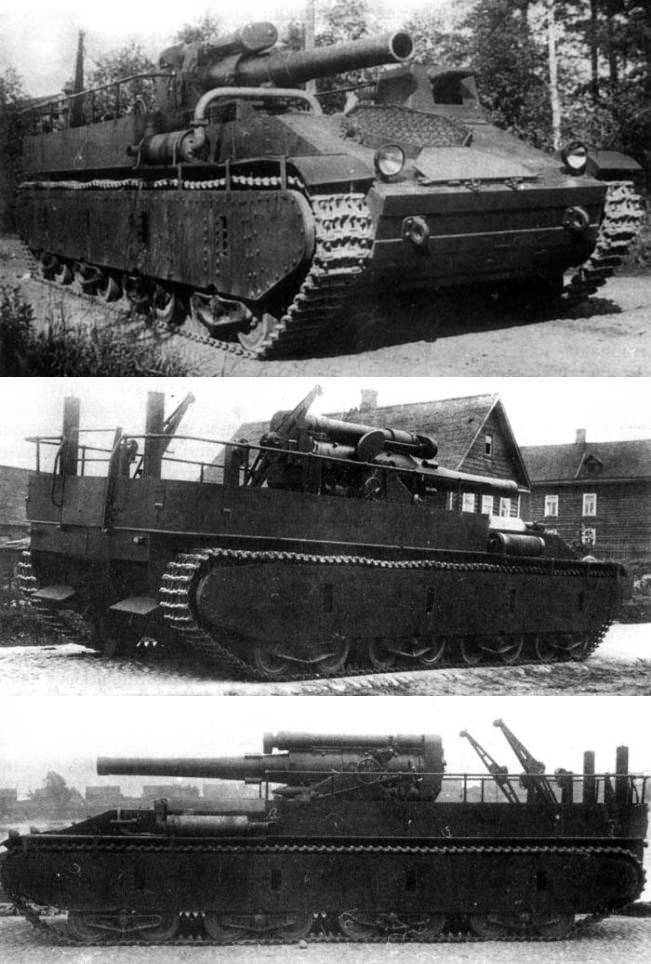
In the 1935 year, this monstrous SAU somehow passed the tests and after the first experimental machine, the second one appeared - a seriously improved pre-series SU-14-1, which tests were quite successful in the 36. (During the tests, the army for some reason decided to replace the powerful 203 mm howitzer with the long-range 152 mm gun, built on the basis of the same B-4 and mounted on the B-4 carriage (respectively, which had the same indecent weight). What is the meaning of this? it is clear - the long-range gun could work calmly and in towed version.
After the quite expected success of the pre-production prototype tests in the 36, the next 37 was supposed to be assembled in the installation batch, and with the 38, to start the serial release!
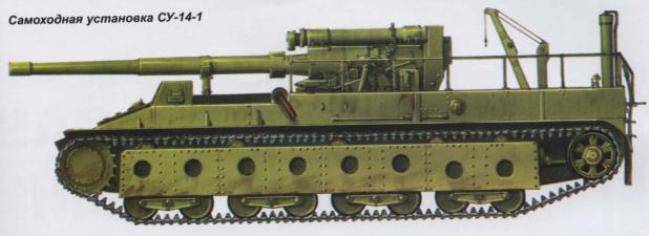
But the plans were plans, but they didn’t accept the SU-14 arms. And it was from what. To master and produce another unique small-series chassis, the industry, which was already overloaded with orders, did not want to - it was more than enough to suffer from T-28 and especially from T-35А. The army, although it liked the power and tactical mobility of the installation, its operational mobility left much to be desired (the installation was trivially overly large).
But, the last nail in the lid of the coffin of the SU-14 was not her flaws, but Syakchinov's arrest, followed by the execution and complete freezing of all his works (above all, the SU-5 triplex and the AT-1 artillery tank - more than worthy successors of the already outdated articles of the tank T-26).
Two copies of the once-made SU-14 were remembered during the Winter War, when it was necessary to find a means to destroy the Finnish pillboxes. The fact is that the towed guns of the RVGK had extremely lousy maneuverability in the theater of operations, which, combined with unimportant instrumental reconnaissance and target designation, led to the fact that the same powerful 203 mm howitzers capable of destroying a reinforced concrete slab with a meter more than one exact hit, could a week with a long (or rather safe for themselves) distance nail in the direction of the intended location of the bunker, but did not disable it completely.
A self-propelled gun was needed, capable of not relying on inaccurate target designation, to hit the target itself on an unequipped terrain with difficult terrain, and to destroy it by shooting direct fire.
Under this task, the artillery part of the SU-14 was heavily booked (armor thickness 30-50 mm), naturally having lost a lot in its maneuverability and reliability of the hodovka (and how could it be otherwise, if its mass grew immediately from 48 to 64 tons!).
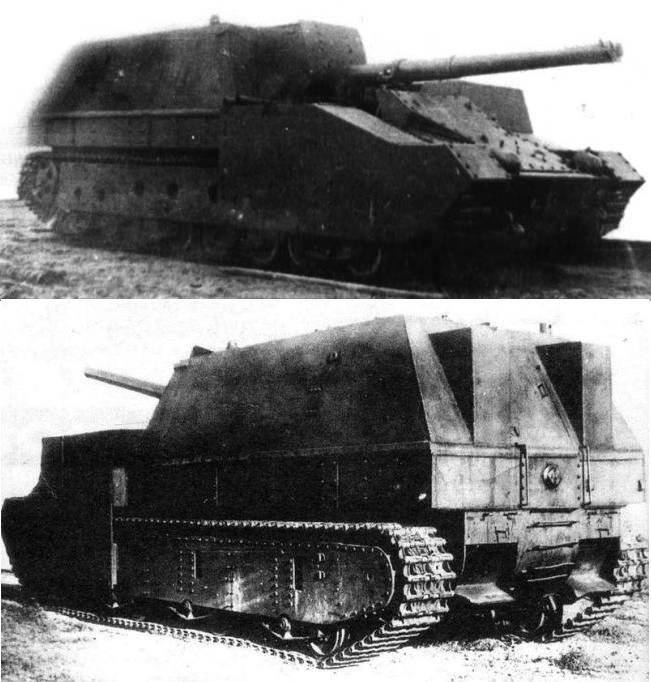
In general, SU-14 did not have time for the Winter War - all the work for them was done by the brave sappers-demolition men under the cover of T-28.
The last chord of a self-propelled career was shooting at the Germans approaching Kubinka.
These mighty cars never went to the series. But effectively using the artillery of a special power of the RVGK in the war that the Germans imposed on us, the USSR could not physically. The artillery of the special power unit of the RVGK was made up of artillery units equipped with 152 mm long-range cannons Br-2, 280 mm mortars Br-5, and mainly 203 mm howitzers B-4, which made up triplex (for example, a single recovered guns with a pre-wrenched dunts, a pre-wired gunner guns, a pre-wired gunner, and a drift gun. the most gun systems that I once wanted to have in the form of self-propelled guns). The problem is that the weight of all these artillery systems was completely megalithic (from 17 to 19 tons) and the most powerful artillery of the Red Army barely had the strength to move them on the ground.
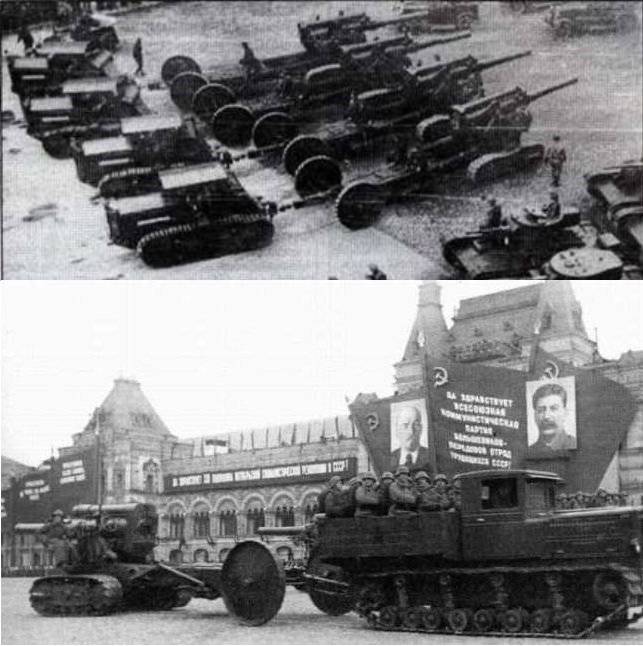
(Let the brave bottom photo from the parade not mislead anyone. The maximum "passport" cargo, under towing which is sharpened "Comintern" 6800 kg, and the mass of arta in the photo, which he drags, at least 17 tons. The tractor in the photo above is even worse - it drags the load almost three times more than the one it is designed for. Accordingly, the speed is less than that of a pedestrian. And how far would he crawl away with such a burden? The only artillery of the Red Army adequate for such a load of power was Voroshilovets. ” just a little over 220 machines were released - this is for almost a thousand artillery barrels of special power RVGK!).
Therefore, the command of the Red Army paid for the best just to withdraw such a sedentary and, moreover, very expensive artillery to the rear (at least that which they had done!). Later, it began to be actively used only when the initiative passed into the hands of the Red Army, to prepare for the breakthroughs of the front, or to storm the capital fortifications.
Naturally, there was no question of any mobility of artillery of a special power of the RVGK.
Now, we will try to depict an alternative SAU TAON (this name is somehow more appealing to me in the imperial army), which can be built (albeit in a small series), and used 41 in maneuverable defensive battles to the fullest.
First of all, it is necessary to somehow solve the problem of the monstrous weight of the same B-4 - in 33, when Syachintov took up the design of the SU-14, no other artillery system was offered to him. And in vain.
In the arsenals of the Red Army, there was then a “good old” 203 mm Vickers Mk-VI howitzer, which was also in service in the armies of Great Britain and the USA.
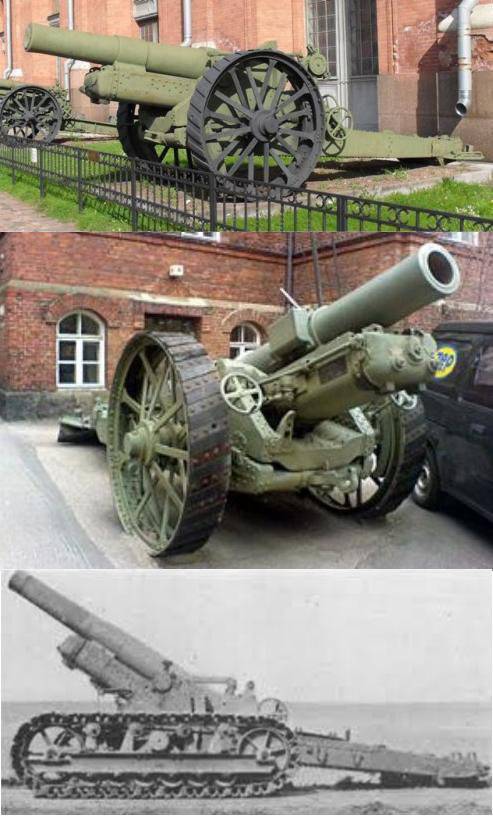
(Top of the 203 mm Mk-VI howitzer on a wheeled carriage of the Russian / Soviet army. In the middle of a British howitzer. Below, the same howitzer, but on a crawler carriage in the USA army)
Russia bought these howitzers during the years of WWI. The 31 gun was purchased in the 16-17. in England, and 41 bought a gun in the 1917-th already in the USA, where they also produced. The Russian Empire simply did not have time to actively use such powerful artillery systems in the First World War, and there was no place for them in the Civic, given its character.
The fact is that these howitzers, unlike many other heavy artillery systems, were not disassembled for transportation by two horse-drawn carriages to the carriage and the trunk, but were initially created in a “unitary” form under the mechanical traction in the form of a powerful tractor with which in the Russian imperial army (not speaking about the troubled times of the Civil War) was tugovato. Due to this circumstance, the howitzers not only survived on their own, but also retained the lion’s share of imported ammunition (EMNIP more than 8 thousand shots), which in Soviet times began with powerful new explosives. The only type of ammunition available (British 90,7-kg land mines), added domestic 98-kg shrapnel (if royal generals called three inches shrapnel as “death slant”, then what is shrapnel eight-inch howitzer ?!).
In the 1936 year, exactly 50 of these fully intact 203 mm howitzers (plus one training) were in service with the RVGK.
The advantage of this howitzer, before the new B-4, especially in the mass. The barrel with a B-4 bolt weighed 5200 kg, while the barrel with a Mk-VI bolt weighed 2900 kg. The carriage of the B-4 - 12500 kg, while the Mk-VI 5288 kg. The total weight of kg 17700 artillery systems vs 8192 kg. Comments as they say are superfluous.
Of course, in favor of the new artillery system its maximum range of 17 km spoke against 9,6 km from the "Englishwoman". But! And this is all the gusto - a huge range is needed for the towed artillery system - it takes a very long time to unfold in a position that has a low rate of fire and is extremely vulnerable to attacks and aviation, and counter-projectile shells of longer-range enemy artillery. In order to reduce risks and create more or less comfortable working conditions, heavy towed artillery should be as long-range as possible (however, the Br-4 mortar created on the B-280 carriage had a range of less than 5 km and this did not bother anyone). This not only increased safety, but also provided a good fire maneuver.
For the ACS, which has a very limited mobile load, the range is not important. She has the opportunity to advance closer to the enemy, quickly shoot back and quickly retire.
Also in favor of the "good old" English howitzer on the ACS says its rate of fire. If the B-4 was able to fire at the pace of the order of 4 minutes for one shot, then the “Englishwoman” was hitting at a pace of 2 shot per minute!
At the same time, both our new B-4 and the old “Englishwoman” had a mechanism for quickly bringing the trunk to the loading angle (it is fixed for both).
And this, by the way, means that on the ACS the process of loading itself can be somewhat mechanized (of course, automation is far away from China, but at least something to ease the hard work of charging). For example, install a vertical holder for five shells (as in a gun shop) with hydraulics (plus backup manual drive) instead of a spring and a long, retractable (so as not to be touched by the rollback) tray with a mechanical, rotated by one fighter, drive to feed the projectile into the breech (on SU-14 it was pushed there by joint efforts as many as four calculation numbers!). And since the angle of horizontal guidance to the ACS can again be increased, then such clips can be installed two - by 5 projectiles, each with a symmetrical angle relative to the longitudinal axis of the ACS. 10 shots - quite decent ammunition for such a powerful self-propelled gun (on the RI SU-14 BK consisted of eight shots). Thus, the number of loaders can be reduced from four to three: the castle, two directly charging and one half charge. Plus, another gunner, mechvod and commander of SAU. Only six crew members.
Rollback tools also can be significantly limited. An effective muzzle brake was developed for the B-4, which our art-commanders of that time routinely refused. This very muzzle brake can be used for our howitzers. You can even go even further. For the same B-4 industry manufactured liners. So it interferes gradually, as the Aglitsky trunks wear out (I hope our scum do not “clean them with a brick!”), In the process of overhauling howitzers, drill out the trunks to install liners in them and attach those muzzle brakes? We will get long-lived trunks with very tenacious and at the same time replaceable liners, a short charging tray (which will accelerate the loading) and a minimum load on the suspension when fired (however, we save the coulter like SU-14 - without it you cannot shoot with high elevation angles even with an effective muzzle brake, without risking the same suspension).
Of course, an attempt was also made to upgrade these howitzers in the Republic of Ingushetia, but, as in the case of other artillery systems, the method of banal forcing. But, the British didn’t leave us any modernization stock in this regard (unlike the German and French colleagues), and these howitzers entered the Great Patriotic War in their original form. And, it should be noted, these howitzers, even against the background of more than eight hundred B-4, were highly valued for their impressive power with very moderate weight. Their only disadvantage (in addition to insufficient range) was considered to be low permissible wagoning speed (as in 6-inch howitzers), due to the total absence of any suspension of the wheel carriage common during the WWW. But, we will have ACS!
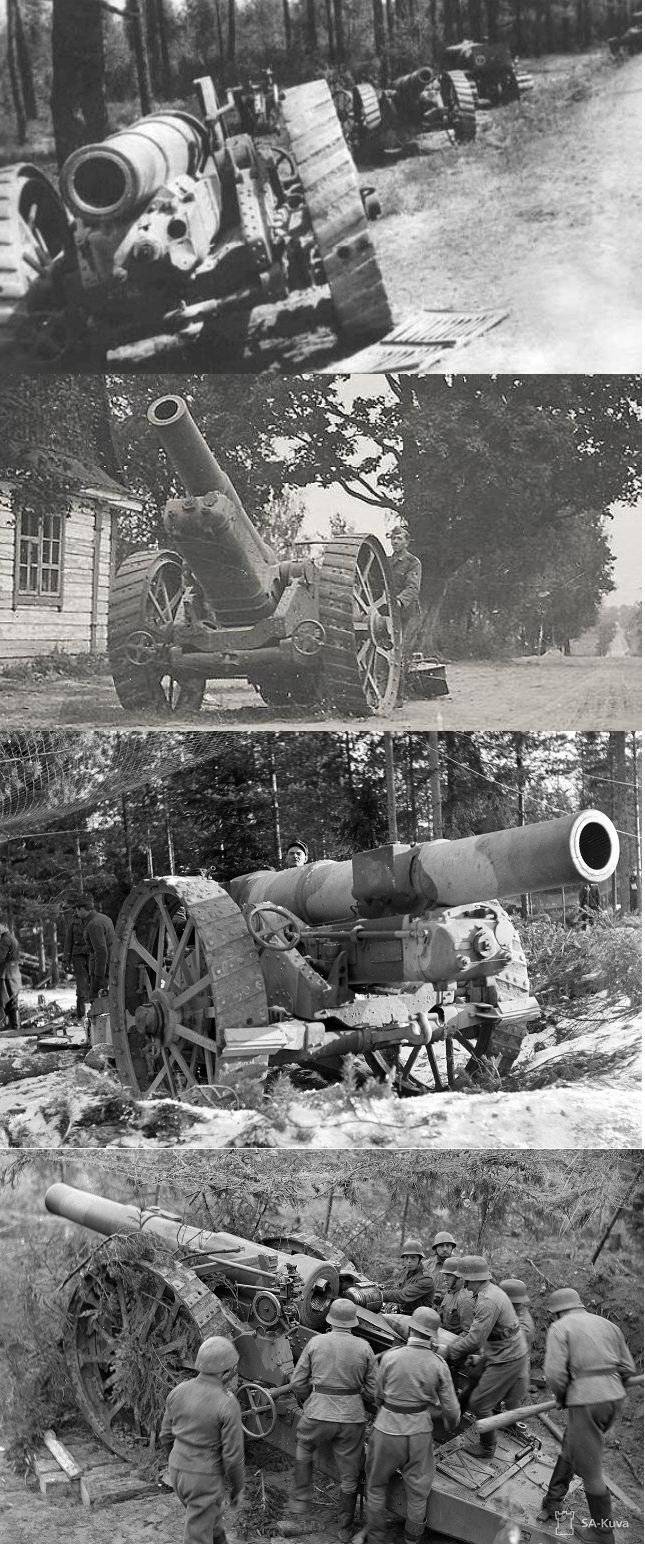
(The column of the RVGK regiment was broken by the Germans on the Brest-Kobrin highway (presumably the 120 th HAP BM had 24 Mk-VI in service). The photo shows the C-65 tractor-arttyagach and the Mk-VI howitzers.
On average, a photo of Fritz, posing with a Soviet howitzer abandoned during the retreat.
Below the Mk-VI is already in the Finnish army. In the photo below, hot Finnish guys at work - probably preparing a gift for the hungry Leningrad kids.)
Now, as for the chassis. I don’t know why our designers invented (more precisely they extruded) a bicycle in the form of a special chassis, when it was already in 35, you could just take a ready-made serial chassis from T-35А.
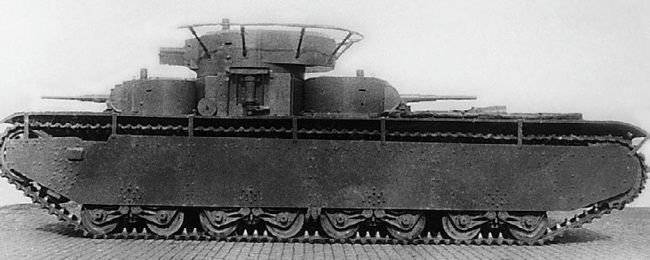
The T-35A weighed 55 T. The first version of the SU-14 is the entire 46 T., and the pre-production SU-14-1 48 t. That is, the T-35А chassis could be used under the B-4 almost in its original form. Only partially disassemble and cut off all the towers in FIG. If anyone doubts - during the war, Grabin was developed and successfully passed the tests of the SAU in the form of a KV-1С tank with 203 mm B-4. (Nobody wants to say anything about overloading the front rollers?)
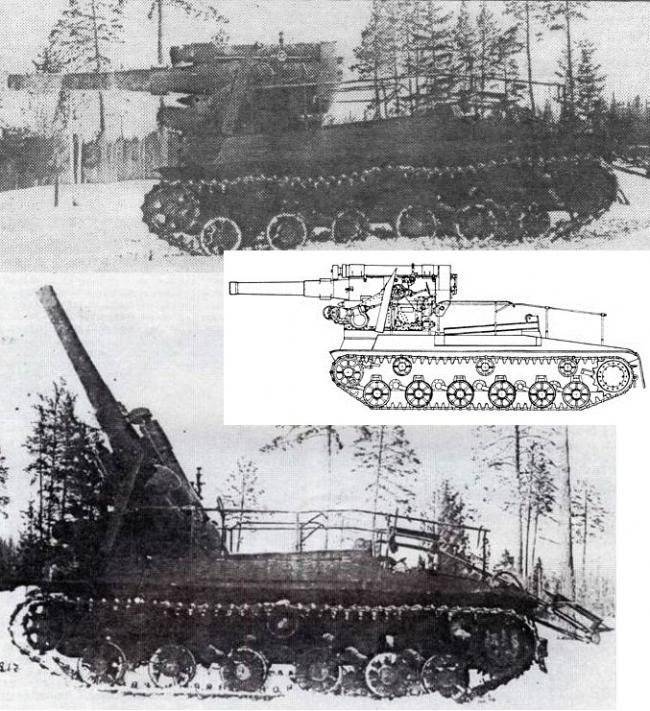
And KV was smaller and lighter than the T-35A. By the way, this is yet another proof of the understanding of the experience of war that for a heavy SAU, caliber is much more important than long range. Otherwise, the long-range 152 mm Br-2 would have been piled up on the cave.
Our artillery system is much easier and we can go even further. Reduce the length of the T-35А case by one trolley (slightly increasing the distance between the remaining three), it is natural to eliminate all the towers and the turret box of the main tower (together with the roof of the case). Corps armor thickness also reduced. If the T-35А, the board defended the 20 mm body armor, plus the 10 mm screen, then the 13 mm bead was enough for us (this armor was full - the T-26 was assembled from it) plus the 8 mm screen. The forehead of the T-35 is a combination of 50 and 30 mm armor details (for some reason, critics of the T-35 about 50 mm details in the form of a front oblique sheet do not recall, stubbornly jabbing in 30 mm “the forehead unable to withstand even 37 mm armor-piercing shells”. After all, on the T-35 Sample 39, instead of 50 mm, the details entered at all 70 mm.
We do not need this luxury. And instead of 30 and 50 mm parts, 22 mm is enough for us. (This reservation was also released in sufficient quantities for BT-7).
It is still impossible to reduce - the rigidity of the case will suffer and you will have to reinforce it with different channels.
We will defend the artillery unit with a simple and spacious cabin. Her body armor: 22 forehead mm, board 13. There are no roofs and aft body armor protection. Instead, canvas awning.
Thus, the total weight of our ACS will be somewhere around 42-43 tons, which should very well affect the aggregate part of the machine. Shoot at high angles of elevation, the self-propelled gun will be using the hydraulically lowered (or, if it fails, the stern coulter of the RI SU-14. On small corners it is not necessary.
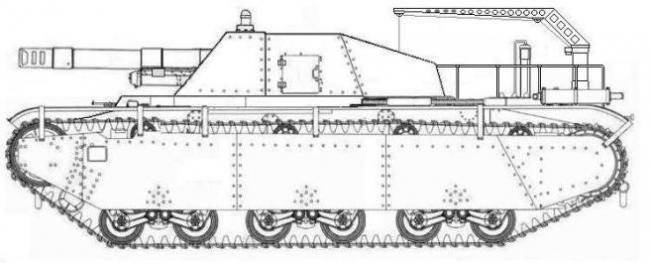
Production. Soviet industry (taking into account cooperation, we are not talking about one KhPZ) painfully long mastered the release of T-35A. Before 34, she struggled with technological problems. Then, overcoming these problems, two years struggled with the quality of the car. But, to make a quality 55-ton colossus, the filling of which was calculated on the weight of the tank from 35 to 38 tons, was almost impossible. The industry understood this and the army understood it.
The army did not like the T-35A for its unreliability and few ordered them even when there were no technological obstacles to release for a long time. The tank was suppressed by the onlookers in parades, and that was enough for the army. No one in the army had any doubt that one day a clumsy T-35 would be replaced by a much more powerful and reliable machine. But, while the developers have requested 3 million rubles. for the project and the prototype of a new heavy tank (T-39), Voroshilov, figuratively speaking, sent them to hell: “not only in this five-year period!”, considering the cost of one serial (main) T-35А (over 525 thousand - as a BT-7 column!) Probably meant something like “not during my life”. Voroshilov had to change this point of view only under the pressure of convincing eloquence of Pavlov who had returned from Spain, who had served as a detonator for developing a new heavy tank.
So here. If the army didn’t like T-35А (and how to love it, if every maneuver ended in a massive case of these elephant-pots?) And by and large was satisfied with its parade functions, for which many tanks are not needed (in general - the fewer they are, the less unpleasant troubles ), then work on the ACS for the RVGK were in full swing. In RI, SU-14 was planned to be mass-produced from the 1938 of the year - when the car was finally fully brought to mind. In AI, the alternative ACS could be fully ready for serial production already at the turn of 34-35. - when the serial production of the T-35A was mastered.
And given that the army was not particularly interested in this tank, the production of ACS could well have been given priority. Moreover, for RVGK there are not so many of them. Yes, a lot and not to do - I remind you - in the Red Army arsenals there were only 50 howitzers Mk-VI.
Thus, taking into account all the above-mentioned factors, the first order was limited to an installation batch of ten cars for the first experienced TAON self-propelled division. These are three batteries of three installations, plus one machine as an unarmed tow truck.
After comprehensive tactical tests, the decision is made to deploy the regiment as part of three divisions and give it all the necessary support units.
In total, the regiment had 27 ACS, three tow truck towers and three bridge laying machines (on the same chassis) so that the self-propelled guns could independently navigate through the moats and narrow rivers on which there are often no capital bridges (the only ones capable of supporting the weight of SUI SPGs). Service units included: a headquarters, a motorized rifle company, a military escort, an anti-aircraft motorized machine-gun company, an auto-battalion with a technical support company, a communications company, a target designation platoon and instrumental artillery reconnaissance, a rear base company and so on. divisions. 9 light armored vehicles, 12 ZSU 4М, 100 trucks and cars for various purposes, 30 high-speed transport tractors and the same number of motorcycles.
At the same time, the self-propelled gun self-propelled gun complemented the new concrete shell.
Modernization. By the end of 30-x, when the situation in the world was heating up with confidence, the leadership of the Red Army decided to form two more self-propelled regiments SAU TAON. But, since the artillery materiel was already lacking for them (from the 50 XKUMUM mm Mk-VI 203 howitzers of the Red Army were installed on the SU-27, some were already destroyed, and others were stored as a reserve) new regiments 14 mm howitzer ML-152 mod. 20
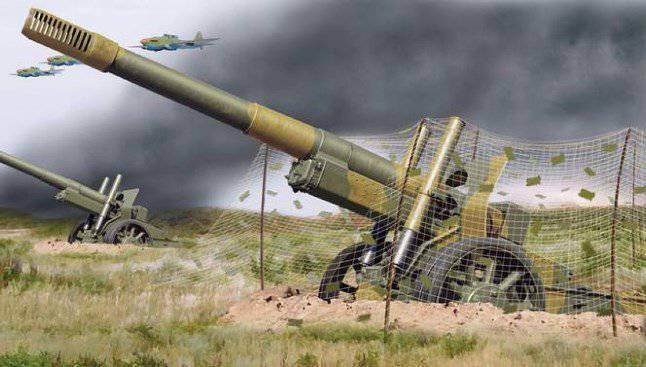
The serial production of this powerful and long-range gun was rapidly growing and by the beginning of the Second World War, it was the basis of both the corps artillery and the heavy artillery of the RVGK (more than 2 800 guns). Such a unification, as it was considered, was only for the benefit, and later on, the same cannon-howitzer was supposed to re-equip the SU-14 of the first regiment SAU TAON.
Here I am forced to make some digression from the outline of the article. The fact is that although I understand all the optimality (perhaps even the inevitability) of the transition to the remarkable in all respects ML-20, I absolutely dislike the idea of reducing the caliber by as much as two inches, which automatically leads to a reduction in the weight of the high-explosive projectile from 90 to 44 kg.
To release new howitzers Mk-VI? Say - senseless waste on any old design and production resources? We recall. In the pre-war USSR, in addition to the 203 mm howitzer B-4, four more (!) 203 mm howitzers and two 203 mm case mortars were designed. Another mortar was designed in 42 - already during the war. Perhaps the need for such a tool was not a small ...
So maybe it was better to create a deeply modernized version of the Mk-VI instead of all this? The Angles only in the course of the PRC twice sat down to modernize it, each time increasing the range. It would be perfect for the Red Army and as an artwork for self-propelled guns TAON, and as a towed corps howitzer. And the funny thing - the ML-20 - which has become one of the best heavy guns of WWII was created through the deep modernization of the six-inch gun from the time of the WWI.
But that "has grown" among the Americans from the same Aglitsky Mk-VI. Like? The Angles claim that ALL American eight-inch howitzers, from the time of WWI to the present day, are direct descendants of the Mk-VI! And to manage to entangle entu charm on the chassis of an average tank is generally cool. More precisely cheap and angry. Highly.
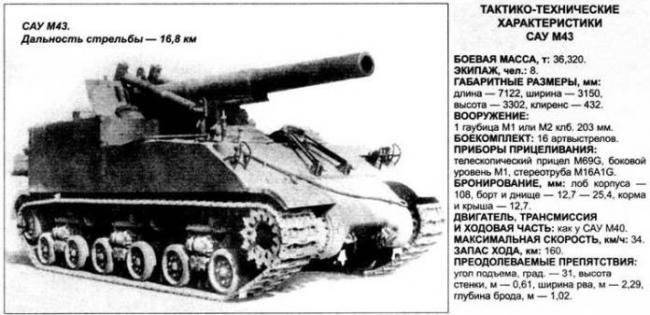
Now, the continuation of the article.
Since the weight of the ML-20 rocking chair is almost a ton less than that of the Mk-VI, an idea appeared to use the saved weight to enhance the SAU armor protection. But, the SU-14 chassis was at its optimum load limit, therefore only the 22 mm screen imposed on the frontal projection was limited to (the total was 44 mm). But from two five-shell 203 mm ammunition went to three six-dummy 152 mm (additional fit along the axis of the machine, between the two previous ones), thereby increasing the ammunition to 18 152 mm shells. Naturally in the nomenclature of ammunition appeared and armor-piercing projectile. In addition, on each ACS installed on the anti-aircraft DT on the rope installation. For firing on the manpower of the enemy, provided for two embrasures - one with a ball mount in the front body armor plate (like tanks), and the second in the front wall of the cabin. The armament, in addition to the same DT and artillery carbines, included one PPD-34 of the SAU commander and a dozen F-1 grenades. Each ACS was equipped with radio telephone communication. The M-17 engine was replaced with the M-17F, thereby increasing the power from 500 to 700 l. with. which increased the speed of the ACS from 31 to 33,5 km / h.
And further. Using the suspension elements and the SAU track, a small cargo trailer protected by 8 mm armor was built specifically for self-propelled guns, on which 18 shells and 36 half charges of second ammunition were placed, plus 10 twenty-liter canisters: 5 with gasoline, 4 with water and one with engine oil.
Outside the armored hull, in a separate laying on the roof, there were a six-person tent with everything necessary for living the calculation of the ACS, a camouflage net for self-propelled guns, a container for drinking water and a week's supply of food. Shantsevy tool was still busy strictly on the ACS. It was believed that a small trailer would not reduce excessively the maneuverability of the ACS, but it would allow a good week to operate an autonomously allocated battery for a specific task.
For overloading the BC from the trailer to the ACS, the self-propelled gun was equipped with a small crane (carrying capacity of the entire 100 kg) with a boom of the required length.
The choice of tracked for a trailer is not accidental - its suspension elements, in fact - a set of spare parts for ACS.
Conclusion The three regiments of self-propelled guns TAON certainly would not change the course of the summer campaign of 41-th. Perhaps they would have shared the fate of most of our technology - abandoned in cuvettes in varying degrees of serviceability. But, who knows, maybe they would be on the contrary, they would have turned up a chance to show themselves - suddenly appearing where at the moment it is especially necessary to bring down the TAON power on the Germans' heads and leave, where their other battered divisions, regiments and battalions are waiting for their help.
And for this chance, perhaps, it was worth ...
For especially patient. Who read such a long article to the end and did not lose interest in the topic, a small application.
After the start of the serial production of the SU-14 (alternative, of course), Syachinov was reminded that in general TAON needs not one self-propelled gun, but triplex, well, in extreme cases, duplex (two arts on one chassis). At the same time, he was given complete freedom of hands regarding the selection of the type of artillery systems.
In order not to be penny wise, the designer chose what, at maximum caliber, fit the T-35A chassis, without overloading it fatally.
The 280 mm siege mortar of Schneider, adopted by the Russian army in the 1912 year, turned out to be such an artillery system.
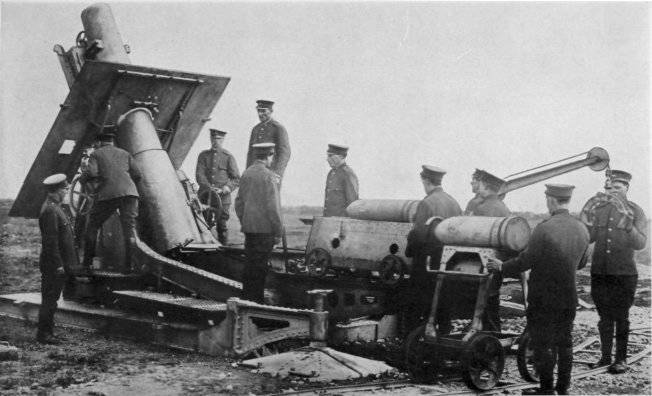
This durynda, hit the 344 kg with an explosive bomb for the distance of 6 km, or newer, light projectiles, respectively:
286,7 kg (explosive F-674) - on 6700 m,
246 kg (concrete G-675) - on 7360 m,
213 kg - on 7860 m,
And finally, the “ultra-light” 200,7 kg (F-674) on 10920 m!
Excellent flexibility of fire provided a wide range of charges.
This tool is well suited for the T-35A chassis. For comparison, let me remind you: the weight of the barrel with RI 203 bolt mm B-4 howitzer mounted on the RI SU-14 was 5200 kg. Barrel weight with a bolt 280 mm mortar arr. 12 was just 3933 kg.
Russia received these mortars from allies for three years: 1915 in 12-ohms, 16 in 8-ohms, and 17 in 6-ohms. Total 26 mortars.
In 1936, the Red Army had arsenals with 21 mortars, of which 5 needed repair. These mortars were highly appreciated, so the necessary repairs were made, and according to the reporting, in the Winter War, the Soviet troops used to destroy the fortifications of the Mannerheim Line 18 mortars, and at the beginning of the Second World War, they had 25 serviceable tools. Agree, if mortars were bad in themselves, or utterly worn out, they wouldn’t be coddled with.
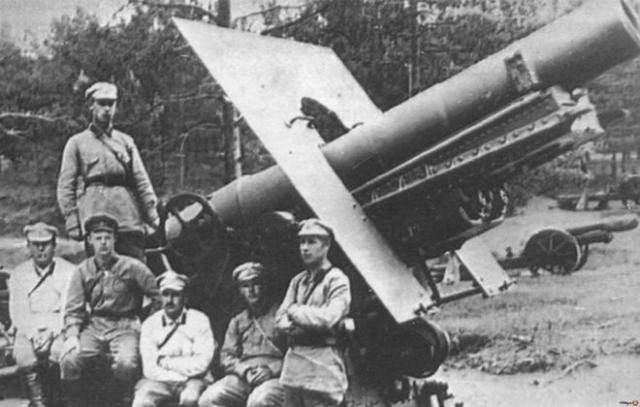
But! The experience of the same Finnish war showed that such heavy artillery systems were not created for movement, not only in rough terrain, but simply along bad roads. Mortar for transportation disassembled into two parts (trunk and carriage), each of which was towed in a separate carriage. So while driving on bad roads to the Mannerheim Line, the third part of the wagons just went out of order.
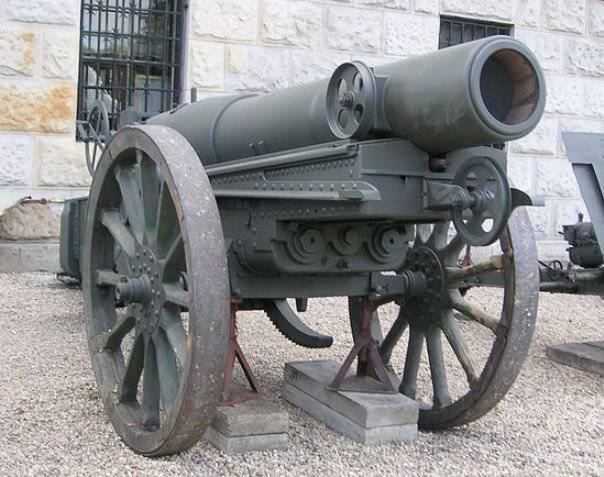
Probably, the understanding of such unimportant transportability of mortars was obvious before, but there were no other options to deliver mortars to the front line in the Republic of Ingushetia. In AI, we eliminate this trouble by creating the most powerful SAU within the Red Army. On a fully disassembled SU-14 chassis, we establish a siege mortar arr. 12 and it will be us with Happiness ...
These mortars were a good addition to the arsenal of special power tools - let me remind you that the new 280 mm mortars Br-5, the industry released in 39-40. total xnumx pieces. Therefore, it would be logical to use old mortars from 47, use 26 to form a single self-propelled mortar regiment of special power (three divisions of 18 guns - three batteries of two guns in the division), and of the eight remaining, five will be stored in reserve, and 6 -2 most detrimental, use as training.
As for the features of the chassis. There are only three changes.
1. Facilitate the design due to the full randronirovaniya chassis. Mortars, with their short range, usually enter into the business when there is simply nothing for the enemy to fight a counter-battery struggle in this sector. Therefore, armor is not really needed. But, if there is an opportunity to save some kind of reservation - I’m all for it.
2. More powerful coulter - the same as on the RI SU-14. Moreover, it is desirable to introduce a mechanism to disable the suspension in general, and even introduce a pallet on which the self-propelled gun can turn, using tracks for this.
3. Charging in the usual way. With such a weight of ammunition, no tricks are likely to roll. And the crane will need a load capacity of at least 300 kg. But, for a mortar, the rate of fire is not so important. She takes the power of each particular shot. On the same Mannerheim Line, 280 mm Mortar shells were not able to resist even DOTs "millionaires."
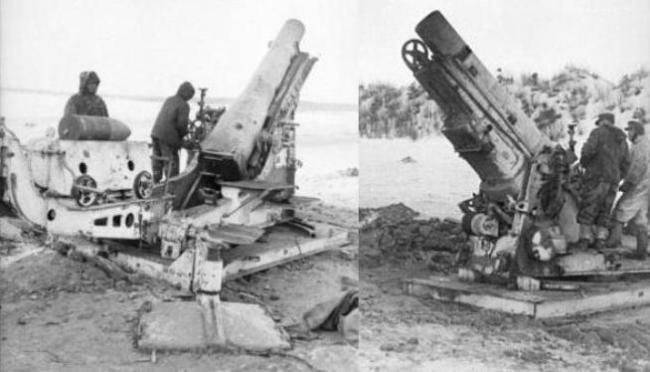
Information